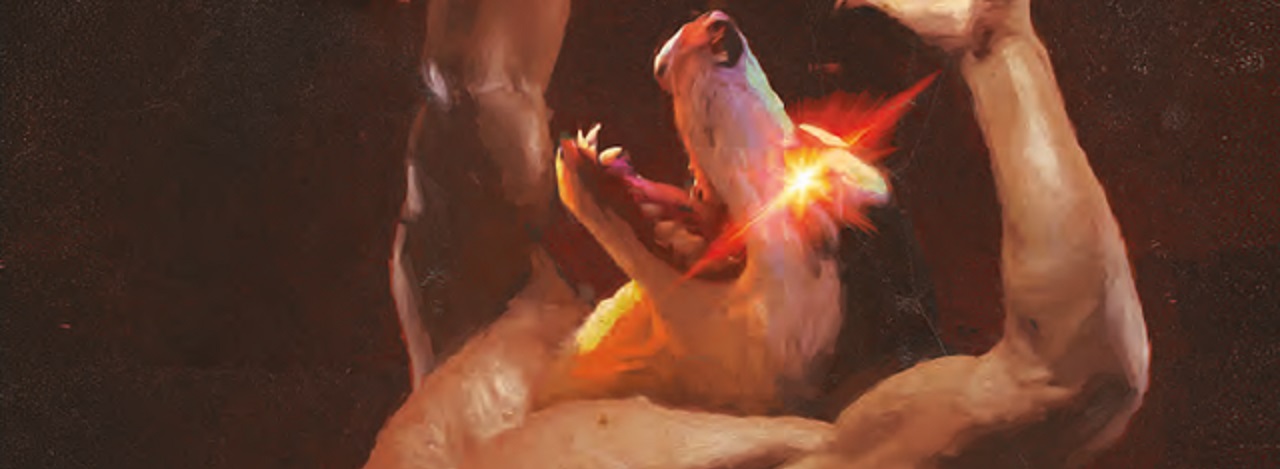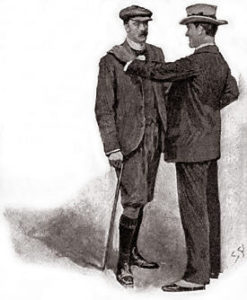
“It seems the very maddest, queerest thing that ever happened to me.”
–The Hound of the Baskervilles by Sir Arthur Conan Doyle
Since their inaugural case, A Study in Scarlet (1887), Sherlock Holmes and Dr. Watson have held many in their thrall. Despite coming to hate the public’s clamouring for Holmes and Watson’s latest exploits – to the point that he killed off the private detective for a decade – Doyle wrote 62 stories, including four novels. The third of these full-length adventures was the seminal The Hound of the Baskervilles (1902). Written in response to public demand (Doyle had not published a Holmes story since 1893), the classic tale concerns murder, mystery, and malevolence lurking on the moors. 120 years later, independent publisher, Lethe Press brings us Adam McOmber’s new novel, Hound of the Baskervilles: a weird, erotic retelling of Doyle’s classic.

cover designed by Matthew Revert
McOmber’s reimagining sends a bitter, despondent Watson to Dartmoor. Throughout his professional partnership with Holmes, Doyle’s Watson personifies an eager puppy, anxious for approval. McOmber’s Watson has reached the end of his tether. Arriving alone at Baskerville Hall, pockets heavy with a revolver and a bottle of laudanum, he aches with loneliness. Wounded by Holmes’ patent apathy, Watson finds himself drawn to Barrymore, a young servant. Reminiscing about past lovers, fantasising about new ones, and stumbling into the uncanny strangeness at the heart of the so-called Baskerville curse, Watson is torn between shame and desire that twist together in a horror of cosmic queerness.
This retelling is not the first to explore queerness. In recent years, BBC’s Sherlock baited their audience with Holmes and Watson’s closeness, while Guy Ritchie’s films offered public displays of affection. Earlier, the Russian TV adaptation leaned heavily into the subtext, and Granada’s take aimed for faithful dramatizations with few changes, one of which kept Watson a bachelor. Doyle may not have intended to imply a romantic relationship, but his penchant for sensual descriptions heightens an already intense atmosphere. In The Speckled Band (1892), for example, Holmes does not merely whisper to Watson; he “…put his lips to my ear.” The Hound of the Baskervilles alone offers endless inspiration. McOmber’s presentation of a frustrated Watson, who appraises a younger man’s physique within the first few pages, strays remarkably little from Doyle’s Watson; his forced separation from Holmes allows space for admiration of other men. Alongside his explicit referral to Holmes as his ‘master’, the original Watson is not far from McOmber’s reimagining.
Here, however, Watson is not the loyal companion of Doyle’s stories. Where the original doctor remains a faithful follower, this one rebels. The relationship has soured, and Watson drowns his sorrows with opiates. Some readers will undoubtedly take issue with this interpretation, not least because so much of the stories’ success hinges on Holmes and Watson’s mutual love and respect. Cleverly, McOmber leans into Holmes’ negative traits: his dismissal of anything he deems unimportant; his dislike of Watson’s stories; and (specific to The Hound of the Baskervilles) his deception. No matter how much Watson loved Holmes, no one would begrudge him a little anger. McOmber takes Watson’s brief ‘raw’ feeling towards Holmes as his starting point. How much coldness and apathy would a person really be able to take? And what happens when an ‘intimate friend’ is no longer wanted? At the heart of this retelling is Watson’s own heartbreak.

Holmes and Watson in one of Sidney Paget’s illustrations from the Strand Magazine
Of course, as with the original, at the centre of the mystery is the Hound itself. Doyle’s novel offers a real dog, its hellish appearance given a scientific explanation. McOmber imagines something otherworldly. Deep below the Grimpen Mire, Watson and Barrymore watch shapes move through a fissure in the earth. Trapped by quicksand on the moors, Watson witnesses the Hound move through the darkness: one moment a dog, then a man, then two men twisting together. What sort of ‘curse’ do the Baskervilles fear? McOmber takes the Civil War backstory – of Hugo Baskerville’s attempted r*pe and successful murder of a young woman – and imbues black magic into his transgressive retelling. Hugo Baskerville lured young men and boys to his home. Charles Baskerville, whose murder Watson means to solve, was found naked and violated. Henry Baskerville suffers from hysteria. As with female sufferers at the time, his treatment comprises stimulation to the point of orgasm. His physician, Dr. Mortimer, pathologises Henry’s affliction, mirroring Doyle’s own view of homosexuality.
Readers seeking the distinct Britishness of Doyle’s work, and especially the Boy’s Own enthusiasm Watson exudes, may be disappointed, but McOmber offers tragedy and mystery in spades. His take on the Stapletons (the Baskervilles’ neighbours) is interesting. Here, Beryl Stapleton appears without her husband as an arch, enigmatic woman. Complex female characters are rare in Holmes canon; Irene Adler remains the most famous and misunderstood. McOmber takes the original Beryl Stapleton – abused, traumatised, and sadly quite flat – and reworks her into a powerfully mysterious presence. She takes a little longer than Watson and the other men to come into her own, but this may be deliberate. Her character arc would benefit from rereads. In fact, McOmber’s layered, often lyrical prose is fairly dripping with invitations to return and pick apart each syllable. Beryl Stapleton is one small part of the puzzle.
Coming to McOmber’s novel as a fan of Doyle’s work and queer horror, there is little to criticise. Amping up the weirdness to a cosmic level, and digging into Watson’s psyche, Hound of the Baskervilles is an inspired take on the classic detective novel. It builds on the Gothic atmosphere of the original (which itself did not shy away from disturbing revelations) and offers a bizarre yet utterly convincing alternative. With tragic romance, hints of folk horror, and twists so shocking, Doyle himself would be proud, Hound of the Baskervilles cements itself as one of the strongest horror novels of the year. At its heart is Watson himself: hurt, ashamed, and nursing wounds no army surgeon can heal.
Hound of the Baskervilles releases October 15th and is now available to preorder from Lethe Press here . Grimoire of Horror thanks the author for providing a copy of the book in exchange for an honest review.
More Book Reviews
Every indie creator hopes to make it big some day, but with limited marketing budgets and the lack of a big publisher/production company backing their projects, success is often a… Hey, GoH gang! Dustin here again with some more Recent Reads that I’d love to recommend to y’all. I rarely have a bad time with the books I read. It takes… Having received this book from Cemetery Dance as a promotional item, I was delighted to have an opportunity to read and review an author and title I had not heard… Stanley Kubrick’s The Shining is most definitely a landmark of horror history. I’ve personally seen it several times and it’s still effectively atmospheric. However, Stephen King’s book, the source material… When I first held the novel The Devil’s Whispers in my hands, I was immediately thrilled to see the influence of classic horror. Lucas Hault not only promises to entertain… If you’ve never read any of Grady Hendrix’s other books, you might find Horrorstor’s mash-up of comedy and horror slightly disconcerting. It blends the main character’s bleak and oftentimes sardonic…Interview with Felix Blackwell, Best Selling Author of Stolen Tongues
Recent Reads: Near the Bone by Christina Henry
Touch the Night by Max Booth III Book Review – Your Mother Should Not Read This Book
Stephen King’s THE SHINING: A Book Review
The Devil’s Whispers by Lucas Hault – Book Review
Horrorstor (2014) Book Review – All The Charm of Ikea Minus the Meatballs
Isabelle is a writer from the UK who enjoys alternative manga and horror films. When not writing, you can probably find Isabelle buying books or obsessing over Martin and Lewis.





